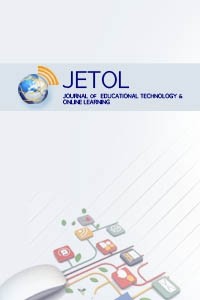Online Teaching Experiences of ELT Instructors
Online Teaching Experiences of ELT Instructors
online education, perceptions about online teaching, online classroom management, online classroom interaction, technical problems in online teaching, emergency remote teaching pedagogical issues in online teaching, virtual classrooms, COVID-19 outbreak,
___
- Bates, A. T. (2001). Managing technological change-strategies for colleges and university leaders. New technology in the human services, 55.
- Cakir, O., Karademir, T., & Erdogdu, F. (2018). Psychological Variables of Estimating Distance Learners' Motivation. Turkish Online Journal of Distance Education, 19(1), 163-182.
- Cenkseven-Onder, F., & Sari, M. (2009). The Quality of School Life and Burnout as Predictors of Subjective Well-Being among Teachers. Educational Sciences: Theory and Practice, 9(3), 1223-1235.
- Chen, J. C., Dobinson, T., & Kent, S. (2020). Students' Perspectives on the Impact of Blackboard Collaborate on Open University Australia (OUA) Online Learning. Journal of Educators Online, 17(1), n1.
- Comas-Quinn, A. (2011). Learning to teach online or learning to become an online teacher: An exploration of teachers’ experiences in a blended learning course. ReCALL, 23(3), 218-232.
- Dörnyei, Z. (1994). Motivation and motivating in the foreign language classroom. The modern language journal, 78(3), 273-284.
- Garrison, R., & Kanuka, H. (2004). Blended learning: Uncovering its transformative potential in higher education. The Internet and Higher Education 7 (2), 95–105.
- Han, J., & Yin, H. (2016). Teacher motivation: Definition, research development and implications for teachers. Cogent Education, 3(1), 1217819.
- Hara, N. (2000). Student distress in a web-based distance education course. Information, Communication & Society, 3(4), 557-579.
- Hodges, C., Moore, S., Lockee, B., Trust, T., & Bond, A. (2020). The Difference Between Emergency Remote Teaching and Online Learning. Recuperado.
- Hrastinski, S., (2008). A study of Asynchronous and Synchronous e-learning methods discovered that each supports different purposes. Educause, 4, 51-56.
- Kızıltepe, Z. (2008). Motivation and demotivation of university teachers. Teachers and Teaching, 14(5-6), 515-530. Little, D. (2007). Language learner autonomy: Some fundamental considerations revisited. International Journal of Innovation in Language Learning and Teaching, 1(1), 14-29.
- Lorenzetti, J. P. (2004). Changing faculty perceptions of online workload. Distance Education Report, 8(20), 1-6.
- Mamun, S. A. K., Rahman, M. M., & Danaher, P. A. (2015). The determinant of faculty attitude to academic (over-) workload: An econometric analysis. The Journal of Developing Areas, 49(6), 373-385.
- Olt, P. A., & Teman, E. D. (2018). A duoethnographic exploration of persistent technological failures in synchronous online education. In Forum Qualitative Sozialforschung/Forum: Qualitative Social Research (Vol. 19, No. 3).
- Pastor, C. K. L. (2020). Sentiment Analysis on Synchronous Online Delivery of Instruction due to Extreme Community Quarantine in the Philippines caused by COVID-19 Pandemic. Asian Journal of Multidisciplinary Studies, 3(1).
- Richardson, P. W., & Watt, H. M. (2010). Current and future directions in teacher motivation research. The decade ahead: Applications and contexts of motivation and achievement, 16, 139-173.
- Rock, M. L., Schoenfeld, N., Zigmond, N., Gable, R. A., Gregg, M., Ploessl, D. M., & Salter, A. (2013). Can you Skype me now? Developing teachers' classroom management practices through virtual coaching. Beyond Behavior, 22(3), 15-23.
- Scott, S., & Palincsar, A. (2013). Sociocultural theory. Education.com.
- Sriwichai, C. (2020). Students' Readiness and Problems in Learning English through Blended Learning Environment. Asian Journal of Education and Training, 6(1), 23-34.
- Trespalacios, J., & Uribe-Florez, L. J. (2020). Developing Online Sense of Community: Graduate Students’ Experiences and Perceptions. Turkish Online Journal of Distance Education, 21(1), 57-72.
- Tynan, B., Ryan, Y., & Lamont‐Mills, A. (2015). Examining workload models in online and blended teaching. British Journal of Educational Technology, 46(1), 5-15.
- Webb, J., Logan, J., & Flaccavento, M. (2017). Delivering synchronous online library instruction at a large-scale academic institution: Practical tips and lessons learned. In Distributed learning (pp. 157-175). Chandos Publishing.
- Wenger, E., & Wegner-Trayner, B. (2007). Introduction to communities of practice. Recuperado el, 7.
- Zhao, C., & Mei, Z. (2016). A Case Study of American and Chinese College Students' Motivation Differences in Online Learning Environment. Journal of Education and Learning, 5(4), 104-112.
- ISSN: 2618-6586
- Yayın Aralığı: Yılda 3 Sayı
- Başlangıç: 2017
- Yayıncı: Gürhan DURAK
Role of emerging technology on academic achievement of students at the University of Cape Coast
Paul NYAGORME, Desire Mawuko Komla AYİTE
Predicting Academic Achievement with Machine Learning Algorithms
Muhammed YILDIZ, Caner BÖREKCİ
Teaching and Learning in resource-limited settings in the face of the COVID-19 pandemic
Teacher candidate perceptions on alternative asynchronous online discussion boards
A Blueprint for In-Service Teacher Training Program in Technology Integration
The Use of Mobile-Based Augmented Reality in Science Learning to Improve Learning Motivation
Online Teaching Experiences of ELT Instructors
Burcu ŞENER, İnci SAĞLAM ERTEM, Ahmet MEÇ
Online Learning in Higher Education during COVID-19 Pandemic: A case of Ghana
Edmond Kwesi AGORMEDAH, Eugene ADU HENAKU, Desire Mawuko Komla AYİTE, Enoch APORİ ANSAH
